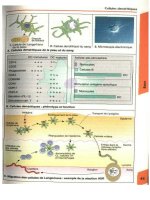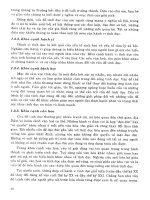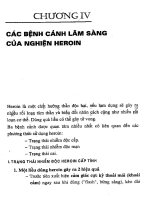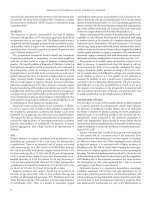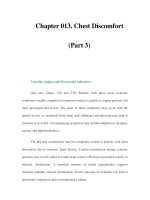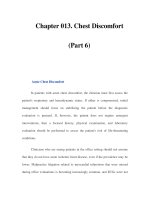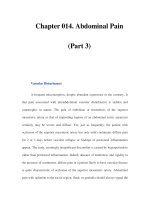Chapter 042. Gastrointestinal Bleeding (Part 3) pptx
Bạn đang xem bản rút gọn của tài liệu. Xem và tải ngay bản đầy đủ của tài liệu tại đây (13.39 KB, 5 trang )
Chapter 042. Gastrointestinal
Bleeding
(Part 3)
Hemorrhagic and Erosive Gastropathy ("Gastritis")
Hemorrhagic and erosive gastropathy, often labeled gastritis, refers to
endoscopically visualized subepithelial hemorrhages and erosions. These are
mucosal lesions and thus do not cause major bleeding. They develop in various
clinical settings, the most important of which are NSAID use, alcohol intake, and
stress. Half of patients who chronically ingest NSAIDs have erosions (15–30%
have ulcers), while up to 20% of actively drinking alcoholic patients with
symptoms of UGIB have evidence of subepithelial hemorrhages or erosions.
Stress-related gastric mucosal injury occurs only in extremely sick patients:
those who have experienced serious trauma, major surgery, burns covering more
than one-third of the body surface area, major intracranial disease, and severe
medical illness (i.e., ventilator dependence, coagulopathy). Significant bleeding
probably does not develop unless ulceration occurs. The mortality rate in these
patients is quite high because of their serious underlying illnesses.
The incidence of bleeding from stress-related gastric mucosal injury or
ulceration has decreased dramatically in recent years, most likely due to better
care of critically ill patients. Pharmacologic prophylaxis for bleeding may be
considered in the high-risk patients mentioned above. Multiple trials document the
efficacy of intravenous H
2
-receptor antagonist therapy, which is more effective
than sucralfate but not superior to a PPI immediate-release suspension given via
nasogastric tube. Prophylactic therapy decreases bleeding but does not lower the
mortality rate.
Other Causes
Other, less frequent causes of UGIB include erosive duodenitis, neoplasms,
aortoenteric fistulas, vascular lesions [including hereditary hemorrhagic
telangiectasias (Osler-Weber-Rendu) and gastric antral vascular ectasia
("watermelon stomach")], Dieulafoy's lesion (in which an aberrant vessel in the
mucosa bleeds from a pinpoint mucosal defect), prolapse gastropathy (prolapse of
proximal stomach into esophagus with retching, especially in alcoholics), and
hemobilia and hemosuccus pancreaticus (bleeding from the bile duct or pancreatic
duct).
SMALL-INTESTINAL SOURCES OF BLEEDING
Small-intestinal sources of bleeding (bleeding from sites beyond the reach
of the standard upper endoscope) are difficult to diagnose and are responsible for
the majority of cases of obscure GIB. Fortunately, small-intestinal bleeding is
uncommon. The most common causes are vascular ectasias and tumors (e.g.,
adenocarcinoma, leiomyoma, lymphoma, benign polyps, carcinoid, metastases,
and lipoma). Other less common causes include Crohn's disease, infection,
ischemia, vasculitis, small-bowel varices, diverticula, Meckel's diverticulum,
duplication cysts, and intussusception. NSAIDs induce small-intestinal erosions
and ulcers and may be a relatively common cause of chronic, obscure GIB; coxibs
induce less small-intestinal injury than traditional NSAIDs.
Meckel's diverticulum is the most common cause of significant lower GIB
(LGIB) in children, decreasing in frequency as a cause of bleeding with age. In
adults <40–50 years, small-bowel tumors often account for obscure GIB; in
patients >50–60 years, vascular ectasias are usually responsible.
Vascular ectasias should be treated with endoscopic therapy if possible.
Surgical therapy can be used for vascular ectasias isolated to a segment of the
small intestine when endoscopic therapy is unsuccessful. Although
estrogen/progesterone compounds have been used for vascular ectasias, a double-
blind trial found no benefit in prevention of recurrent bleeding. Isolated lesions,
such as tumors, diverticula, or duplications, are generally treated with surgical
resection.
COLONIC SOURCES OF BLEEDING
The incidence of hospitalizations for LGIB is about one-fifth that for
UGIB. Hemorrhoids are probably the most common cause of LGIB; anal fissures
also cause minor bleeding and pain. If these local anal processes, which rarely
require hospitalization, are excluded, the most common causes of LGIB in adults
are diverticula, vascular ectasias (especially in the proximal colon of patients >70
years), neoplasms (primarily adenocarcinoma), and colitis—most commonly
infectious or idiopathic inflammatory bowel disease, but occasionally ischemic or
radiation-induced. Uncommon causes include post-polypectomy bleeding, solitary
rectal ulcer syndrome, NSAID-induced ulcers or colitis, trauma, varices (most
commonly rectal), lymphoid nodular hyperplasia, vasculitis, and aortocolic
fistulas. In children and adolescents, the most common colonic causes of
significant GIB are inflammatory bowel disease and juvenile polyps.
Diverticular bleeding is abrupt in onset, usually painless, sometimes
massive, and often from the right colon; minor and occult bleeding is not
characteristic. Clinical reports suggest that bleeding colonic diverticula stop
bleeding spontaneously in ~80% of patients and rebleed in about 20–25% of
patients. Intraarterial vasopressin or embolization by superselective technique
should stop bleeding in a majority of patients. If bleeding persists or recurs,
segmental surgical resection is indicated.
Bleeding from right colonic vascular ectasias in the elderly may be overt or
occult; it tends to be chronic and only occasionally is hemodynamically
significant. Endoscopic hemostatic therapy may be useful in the treatment of
vascular ectasias, as well as discrete bleeding ulcers and post-polypectomy
bleeding, while endoscopic polypectomy, if possible, is used for bleeding colonic
polyps. Surgical therapy is generally required for major, persistent, or recurrent
bleeding from the wide variety of colonic sources of GIB that cannot be treated
medically, angiographically, or endoscopically.

